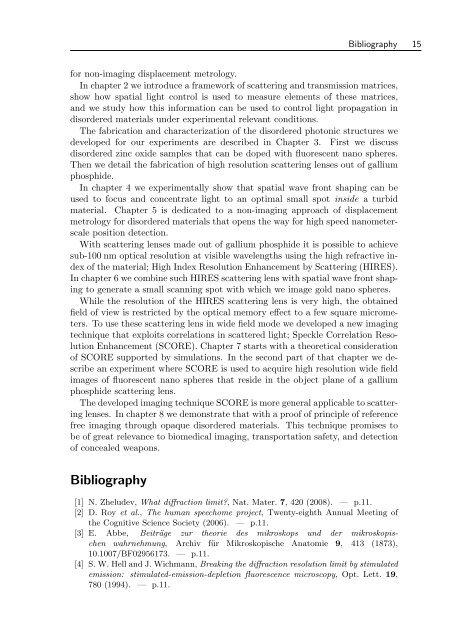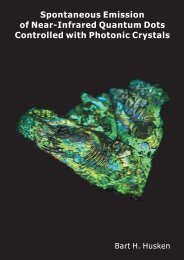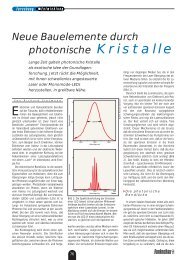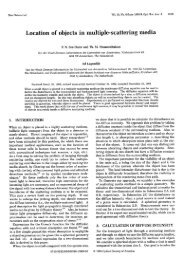Disorder-Enhanced Imaging with Spatially Controlled Light
Disorder-Enhanced Imaging with Spatially Controlled Light
Disorder-Enhanced Imaging with Spatially Controlled Light
You also want an ePaper? Increase the reach of your titles
YUMPU automatically turns print PDFs into web optimized ePapers that Google loves.
Bibliography 15<br />
for non-imaging displacement metrology.<br />
In chapter 2 we introduce a framework of scattering and transmission matrices,<br />
show how spatial light control is used to measure elements of these matrices,<br />
and we study how this information can be used to control light propagation in<br />
disordered materials under experimental relevant conditions.<br />
The fabrication and characterization of the disordered photonic structures we<br />
developed for our experiments are described in Chapter 3. First we discuss<br />
disordered zinc oxide samples that can be doped <strong>with</strong> fluorescent nano spheres.<br />
Then we detail the fabrication of high resolution scattering lenses out of gallium<br />
phosphide.<br />
In chapter 4 we experimentally show that spatial wave front shaping can be<br />
used to focus and concentrate light to an optimal small spot inside a turbid<br />
material. Chapter 5 is dedicated to a non-imaging approach of displacement<br />
metrology for disordered materials that opens the way for high speed nanometerscale<br />
position detection.<br />
With scattering lenses made out of gallium phosphide it is possible to achieve<br />
sub-100 nm optical resolution at visible wavelengths using the high refractive index<br />
of the material; High Index Resolution Enhancement by Scattering (HIRES).<br />
In chapter 6 we combine such HIRES scattering lens <strong>with</strong> spatial wave front shaping<br />
to generate a small scanning spot <strong>with</strong> which we image gold nano spheres.<br />
While the resolution of the HIRES scattering lens is very high, the obtained<br />
field of view is restricted by the optical memory effect to a few square micrometers.<br />
To use these scattering lens in wide field mode we developed a new imaging<br />
technique that exploits correlations in scattered light; Speckle Correlation Resolution<br />
Enhancement (SCORE). Chapter 7 starts <strong>with</strong> a theoretical consideration<br />
of SCORE supported by simulations. In the second part of that chapter we describe<br />
an experiment where SCORE is used to acquire high resolution wide field<br />
images of fluorescent nano spheres that reside in the object plane of a gallium<br />
phosphide scattering lens.<br />
The developed imaging technique SCORE is more general applicable to scattering<br />
lenses. In chapter 8 we demonstrate that <strong>with</strong> a proof of principle of reference<br />
free imaging through opaque disordered materials. This technique promises to<br />
be of great relevance to biomedical imaging, transportation safety, and detection<br />
of concealed weapons.<br />
Bibliography<br />
[1] N. Zheludev, What diffraction limit?, Nat. Mater. 7, 420 (2008). — p.11.<br />
[2] D. Roy et al., The human speechome project, Twenty-eighth Annual Meeting of<br />
the Cognitive Science Society (2006). — p.11.<br />
[3] E. Abbe, Beiträge zur theorie des mikroskops und der mikroskopischen<br />
wahrnehmung, Archiv für Mikroskopische Anatomie 9, 413 (1873),<br />
10.1007/BF02956173. — p.11.<br />
[4] S. W. Hell and J. Wichmann, Breaking the diffraction resolution limit by stimulated<br />
emission: stimulated-emission-depletion fluorescence microscopy, Opt. Lett. 19,<br />
780 (1994). — p.11.









